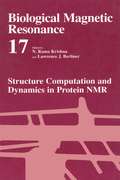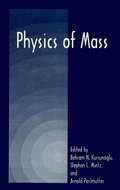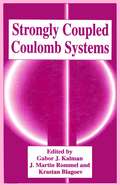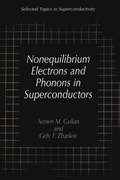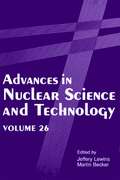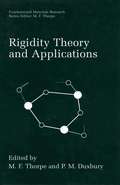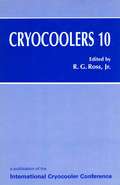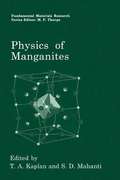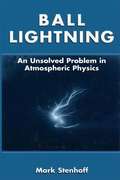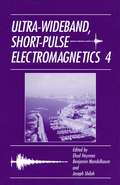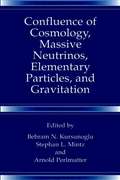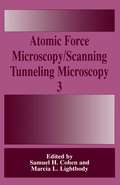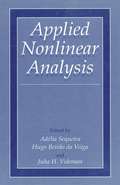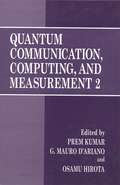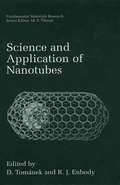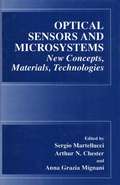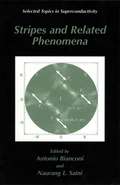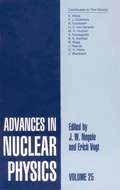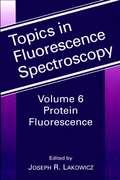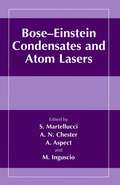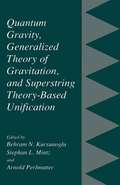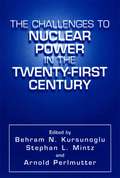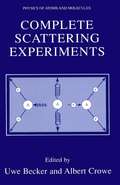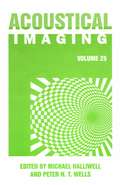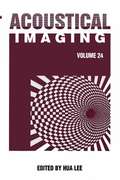- Table View
- List View
Structure Computation and Dynamics in Protein NMR (Biological Magnetic Resonance #17)
by N. Rama Krishna Lawrence J. BerlinerVolume 17 is the second in a special topic series devoted to modern techniques in protein NMR, under the Biological Magnetic Resonance series. Volume 16, with the subtitle Modern Techniques in Protein NMR , is the first in this series. These two volumes present some of the recent, significant advances in the biomolecular NMR field with emphasis on developments during the last five years. We are honored to have brought together in these volume some of the world s foremost experts who have provided broad leadership in advancing this field. Volume 16 contains - vances in two broad categories: I. Large Proteins, Complexes, and Membrane Proteins and II. Pulse Methods. Volume 17 contains major advances in: I. Com- tational Methods and II. Structure and Dynamics. The opening chapter of volume 17 starts with a consideration of some important aspects of modeling from spectroscopic and diffraction data by Wilfred van Gunsteren and his colleagues. The next two chapters deal with combined automated assignments and protein structure determination, an area of intense research in many laboratories since the traditional manual methods are often inadequate or laborious in handling large volumes of NMR data on large proteins. First, Werner Braun and his associates describe their experience with the NOAH/DIAMOD protocol developed in their laboratory.
Physics of Mass
by Behram N. Kursunogammalu Stephan L. Mintz Arnold PerlmutterSponsored by the Global Foundation, Inc., these proceedings are derived from the International Conference on Orbis Scientiae II. Topics covered include: gravitational mass, neutrino mass, particle masses, cosmological masses, susy masses, and big bang creation of mass.
Strongly Coupled Coulomb Systems
by Gabor J. Kalman Krastan Blagoev J. Martin RommelThe International Conference on Strongly Coupled Coulomb Systems was held on the campus of Boston College in Newton, Massachusetts, August 3–10, 1997. Although this conference was the first under a new name, it was the continuation of a series of international meetings on strongly coupled plasmas and other Coulomb systems that started with the NATO Summer Institute on Strongly Coupled Plasmas, almost exactly twenty years prior to this conference, in July of 1977 in Orleans la Source, France. Over the intervening period the field of strongly coupled plasmas has developed vigorously. In the 1977 meeting the emphasis was on computer (Monte Carlo and molecular dynamics) simulations which provided, for the first time, insight into the rich and new physics of strongly coupled fully ionizedplasmas. While theorists scrambled to provide a theoretical underpinning for these results, there was also a dearth of real experimental input to reinforce the computer simulations. Over the past few years this situation has changed drastically and a variety of direct experiments on classical, pure, strongly correlated plasma systems (charged particle traps, dusty plasmas, electrons on the surface of liquid helium, etc. ) have become available. Even more importantly, entire new area of experimental interest in condensed matter physics have opened up through developments in nano-technology and the fabrication of low-dimensional systems, where the physical behavior, in many ways, is similar to that in classical plasmas. Strongly coupled plasma physics has always been an interdisciplinaryactivity.
Nonequilibrium Electrons and Phonons in Superconductors: Selected Topics in Superconductivity (Selected Topics in Superconductivity)
by Armen M. Gulian Gely F. ZharkovAdvances in Nuclear Science and Technology (Advances in Nuclear Science & Technology #26)
by Jeffery Lewins Martin BeckerSince its initiation in 1962, this series has presented authoritative reviews of the most important developments in nuclear science and engineering, from both theoretical and applied perspectives. In addition, many original contributions are included.
Rigidity Theory and Applications (Fundamental Materials Research)
by M. F. Thorpe P. M. DuxburyAlthough rigidity has been studied since the time of Lagrange (1788) and Maxwell (1864), it is only in the last twenty-five years that it has begun to find applications in the basic sciences. The modern era starts with Laman (1970), who made the subject rigorous in two dimensions, followed by the development of computer algorithms that can test over a million sites in seconds and find the rigid regions, and the associated pivots, leading to many applications. This workshop was organized to bring together leading researchers studying the underlying theory, and to explore the various areas of science where applications of these ideas are being implemented.
Cryocoolers 10
by Ronald G. Jr. RossCryocoolers 10 is the premier archival publication of the latest advances and performance of small cryogenic refrigerators designed to provide localized cooling for military, space, semi-conductor, medical, computing, and high-temperature superconductor cryogenic applications in the 2-200 K temperature range. Composed of papers written by leading engineers and scientists in the field, Cryocoolers 10 reports the most recent advances in cryocooler development, contains extensive performance test results and comparisons, and relates the latest experience in integrating cryocoolers into advanced applications.
Physics of Manganites (Fundamental Materials Research)
by T. A. Kaplan S. D. MahantiThis series of books, which is published at the rate of about one per year, addresses fundamental problems in materials science. The contents cover a broad range of topics from small clusters of atoms to engineering materials and involves chemistry, physics, materials science and engineering, with length scales ranging from Ångstroms up to millimeters. The emphasis is on basic science rather than on applications. Each book focuses on a single area of current interest and brings together leading experts to give an up to date discussion of their work and the work of others. Each article contains enough references that the interested reader can access the relevant literature. Thanks are given to the Center for Fundamental Materials Research at Michigan State University for supporting this series. M. F. Thorpe, Series Editor E mail: thorpe@pa. msu. edu V PREFACE This book records invited lectures given at the workshop on Physics of Manganites, held at Michigan State University, July 26 29, 1998. Doped manganites are an interesting class of compounds that show both metal insulator and ferromagnetic to paramagnetic transitions at the same temperature. This was discovered in the early 1950s by Jonker and van Santen and basic theoretical ideas were developed by Zener (1951), Anderson and Hasegawa (1955), and deGennes (1960) to explain these transitions and related interesting observations.
Ball Lightning: An Unsolved Problem in Atmospheric Physics
by Mark StenhoffDown comes a deluge of sonorous hail, Or prone-descending rain. Wide-rent, the clouds Pour a whole flood, and yet, its flame unquenched, Th’unconquerable lightning struggles through. Ragged and fierce, or in red whirling balls, And fires the mountains with redoubled rage. Black from the stroke, above, the smould’ring pine Stands a sad shattered trunk; and, stretched below, A lifeless group the blasted cattle lie. James Thompson, “The Seasons” (1727) have been investigating ball lightning for more than two decades. I published a ball lightning report in Nature in 1976 that received worldwide publicity and I consequently many people wrote to me with accounts of their own experiences. Within a very short time, I had accumulated about 200 firsthand accounts, and the file has continued to grow steadily since then. Several things impressed me. Few of those who wrote to me had any detailed foreknowledge of ball lightning at the time of their observation. Nonetheless, once reports of other phenomena such as St. Elmo’s fire had been eliminated, the remaining descriptions were remarkably consistent. Furthermore, nearly all who contacted me were keen to have an explanation of what they had seen and seemed entirely sincere.
Ultra-Wideband Short-Pulse Electromagnetics 4
by Ehud Heyman Benjamin Mandelbaum Joseph ShilohIn the tradition of the previous three conferences, the proceedings of the 4th Ultra-Wideband Short-Pulse Electromagnetics Conference explores topics including pulse generation and detection; broadband electronic systems; antennas - theory, design, experiments and systems; pulse propagation; scattering theory; signal processing; and buried targets - detection and identification.
Confluence of Cosmology, Massive Neutrinos, Elementary Particles, and Gravitation
by Behram N. Kursunogammalu Stephan L. Mintz Arnold PerlmutterJustbefore the preliminary programof Orbis Scientiae 1998 went to press the news in physics was suddenly dominated by the discovery that neutrinos are, after all, massive particles. This was predicted by some physicists including Dr. Behram Kusunoglu, who had apaper published on this subject in 1976 in the Physical Review. Massive neutrinos do not necessarily simplify the physics of elementary particles but they do give elementary particle physics a new direction. If the dark matter content ofthe universe turns out to consist ofneutrinos, the fact that they are massive should make an impact on cosmology. Some of the papers in this volume have attempted to provide answers to these questions. We have a long way to go before we find the real reasons for nature’s creation of neutrinos. Another neutrino-related event was the passing of their discoverer, Fredrick Reines: The trustees of the Global Foundation, members of the Orbis Scientiae 1998, dedicate this conference to Fredrick Reines of the University of California at Irvine. The late Professor Reines was a loyal and active member of these series of conferences on the frontiers of physics and cosmology since 1964. He also sewed as one of the trustees of the Global Foundation for the past three years. Professor Reines discovered the most elusive particle, the neutrino, in 1954. We are proud to say that we recognized the importance of this discovery by awarding him the J.
Atomic Force Microscopy/Scanning Tunneling Microscopy 3
by Samuel H. Cohen Marcia L. LightbodyThe Foundation for Advances in Medicine and Science (FAMS), the organizers of SCANNING 98, sponsored its third annual Atomic Force Microscopy/Scanning Tunneling Microscopy Symposium at the Omni Inner Harbor Hotelin Baltimore, Maryland, from May 9 to 12, 1998. This book represents the compilation of papers that were presented at the AFM/STM Symposium as well as a few that were presented at SCANNING 96 and SCANNING 97 meetings that took place in Monterey, California. The purpose of the symposium was to provide an interface between scientists and engineers, representatives of industry, government and academia, all of whom have a common interest in probe microscopies. The meetings offered an ideal forum where ideas could easily be exchanged and where individuals from diverse fields who are on the cutting edge ofprobe microscopy research could communicate with one another. Experts in probe microscopy from around the world representing a wide range of disciplines including physics, biotechnology, nanotechnology, chemistry, material science, etc., were invited to participate. The format of the meeting was structured so as to encourage communication among these individuals. During the first day’s sessions papers were presented on general topics such as application of scanning probe microscopy in materials science; STM and scanning tunneling spectroscopy of organic materials; fractal analysis in AFM; and nanomanipulation. Other papers presented included unexpected ordering of a molecule; synthesis ofpeptides and oligonucleotides; and analysis oflunar soils from Apollo 11.
Applied Nonlinear Analysis
by Adélia Sequeira Hugo Beirão Da Veiga Juha H. VidemanThis book is meant as a present to honor Professor on the th occasion of his 70 birthday. It collects refereed contributions from sixty-one mathematicians from eleven countries. They cover many different areas of research related to the work of Professor including Navier-Stokes equations, nonlinear elasticity, non-Newtonian fluids, regularity of solutions of parabolic and elliptic problems, operator theory and numerical methods. The realization of this book could not have been made possible without the generous support of Centro de Matemática Aplicada (CMA/IST) and Fundação Calouste Gulbenkian. Special thanks are due to Dr. Ulrych for the careful preparation of the final version of this book. Last but not least, we wish to express our gratitude to Dr. for her invaluable assistance from the very beginning. This project could not have been successfully concluded without her enthusiasm and loving care for her father. On behalf of the editors ADÉLIA SEQUEIRA v honored by the Order of Merit of the Czech Republic by Václav Havel, President of the Czech Republic, on the October 28, 1998, Professor Emeritus of Mathematics at the Charles University in Prague, Presidential Research Professor at the Northern Illinois University and Doctor Honoris Causa at the Technical University of Dresden, has been enriching the Czech and world mathematics with his new ideas in the areas of partial differential equations, nonlinear functional analysis and applications of the both disciplines in continuum mechanics and hydrodynamics for more than forty years.
Quantum Communication, Computing, and Measurement 2
by Prem Kumar Osamu Hirota G. Mauro D'ArianoBased on the Fourth International Conference on Quantum Communication, Measurement and Computing, this volume brings together scientists working in the interdisciplinary fields of quantum communication science and technology. Topics include quantum information theory, quantum computing, stochastic processes and filtering, and quantum measurement theory
Science and Application of Nanotubes (Fundamental Materials Research)
by D. Tománek R. J. EnbodyThis series of books, which is published at the rate of about one per year, addresses fundamental problems in materials science. The contents cover a broad range of topics from small clusters of atoms to engineering materials and involve chemistry, physics, materials science, and engineering, with length scales ranging from Ångstroms up to millimeters. The emphasis is on basic science rather than on applications. Each book focuses on a single area of current interest and brings together leading experts to give an up-to-date discussion of their work and the work of others. Each article contains enough references that the interested reader can access the relevant literature. Thanks are given to the Center for Fundamental Materials Research at Michigan State University for supporting this series. M. F. Thorpe, Series Editor E-mail: thorpe@pa. msu. edu East Lansing, Michigan V PREFACE It is hard to believe that not quite ten years ago, namely in 1991, nanotubes of carbon were discovered by Sumio Iijima in deposits on the electrodes of the same carbon arc apparatus that was used to produce fullerenes such as the “buckyball”. Nanotubes of carbon or other materials, consisting ofhollow cylinders that are only a few nanometers in diameter, yet up to millimeters long, are amazing structures that self-assemble under extreme conditions. Their quasi-one-dimensional character and virtual absence of atomic defects give rise to a plethora of unusual phenomena.
Optical Sensors and Microsystems: New Concepts, Materials, Technologies
by Arthur N. Chester Anna Grazia Mignani S. MartellucciProceedings of the 22nd Course of the International School of Quantum Electronics, held 27 November-2 December 1997, in Erice, Italy. In recent years, fiber optical sensors and optical microsystems have assumed a significant role in sensing and measurement of many kinds. These optical techniques are utilised in a wide range of fields, including biomedicine, environmental sensing, mechanical and industrial measurement, and art preservation. This volume, an up-to-date survey of optical sensors and optical microsystems, aims at combining a tutorial foundation with analysis of current research in this area, and an extensive coverage of both technology and applications.
Stripes and Related Phenomena (Selected Topics in Superconductivity)
by Antonio Bianconi Naurang L. SainiThe problem of superconductors has been a central issue in Solid State Physics since 1987. After the discovery of superconductivity (HTSC) in doped perovskites, it was realized that the HTSC appears in an unknown complex electronic phase of c- densed matter. In the early years, all theories of HTSC were focused on the physics of a homogeneous 2D metal with large electron–electron correlations or on a 2D polaron gas. Only after 1990, a novel paradigm started to grow where this 2D metallic phase is described as an inhomogeneous metal. This was the outcome of several experimental evidences of phase separation at low doping. Since 1992, a series of conferences on phase separation were organized to allow scientists to get together to discuss the phase separation and related issues. Following the discovery by the Rome group in 1992 that “the charges move freely mainly in one direction like the water running in the grooves in the corrugated iron foil,” a new scenario to understand superconductivity in the superconductors was open. Because the charges move like rivers, the physics of these materials shifts toward the physics of novel mesoscopic heterostructures and complex electronic solids. Therefore, understanding the striped phases in the perovskites not only provides an opportunity to understand the anomalous metallic state of cuprate superconductors, but also suggests a way to design new materials of technological importance. Indeed, the stripes are becoming a field of general scientific interest.
Advances in Nuclear Physics: Volume 25 (Advances in Nuclear Physics #25)
by J. W. Negele Erich W. VogtFor the first half of the 20th Century, low-energy nuclear physics was one of the dominant foci of all of science. Then accelerators prospered and energies rose, leading to an increase of interest in the GeV regime and beyond. The three articles comprising this end-of-century Advances in Nuclear Physics present a fitting and masterful summary of the energy regimes through which nuclear physics has developed and promises to develop in future. One article describes new information about fundamental symmetries found with kV neutrons. Another reviews our progress in understanding nucleon-nucleus scattering up to 1 GeV. The third analyzes dilepton production as a probe for quark-gluon plasmas generated in relativistic heavy-ion collisions.
Protein Fluorescence (Topics in Fluorescence Spectroscopy #6)
by Joseph R. LacowiczThe intrinsic or natural fluorescence of proteins is perhaps the most complex area of biochemical fluorescence. Fortunately the fluorescent amino acids, phenylalanine, tyrosine and tryptophan are relatively rare in proteins. Tr- tophan is the dominant intrinsic fluorophore and is present at about one mole % in protein. As a result most proteins contain several tryptophan residues and even more tyrosine residues. The emission of each residue is affected by several excited state processes including spectral relaxation, proton loss for tyrosine, rotational motions and the presence of nearby quenching groups on the protein. Additionally, the tyrosine and tryptophan residues can interact with each other by resonance energy transfer (RET) decreasing the tyrosine emission. In this sense a protein is similar to a three-particle or mul- particle problem in quantum mechanics where the interaction between particles precludes an exact description of the system. In comparison, it has been easier to interpret the fluorescence data from labeled proteins because the fluorophore density and locations could be controlled so the probes did not interact with each other. From the origins of biochemical fluorescence in the 1950s with Prof- sor G. Weber until the mid-1980s, intrinsic protein fluorescence was more qualitative than quantitative. An early report in 1976 by A. Grindvald and I. Z. Steinberg described protein intensity decays to be multi-exponential. Attempts to resolve these decays into the contributions of individual tryp- phan residues were mostly unsuccessful due to the difficulties in resolving closely spaced lifetimes.
Bose-Einstein Condensates and Atom Lasers
by S. Martellucci Alain Aspect Arthur N. Chester Massimo InguscioProceedings of the International School of Quantum Electronics 27th course on Bose Einstein Condensates and Atom Lasers, October 19-24, 1999, Erice, Italy. Since the experimental demonstration of Bose Einstein Condensation in dilute atomic gases there has been an explosion of interest in the properties of this novel macroscopic quantum system. The book covers the methods used to produce these new samples of coherent atoms, their manipulation and the study of their properties. Emphasis is given to the anticipated development of new types of sources, which more and more resemble traditional types of lasers. Because of recent new applications and increasing demand for lasers, sensors and associated instrumentation, the chapters also cover current developments in the basic techniques, materials and applications in the field of the generation of coherent atoms.
Quantum Gravity, Generalized Theory of Gravitation, and Superstring Theory-Based Unification
by Behram N. Kursunogammalu Stephan L. Mintz Arnold PerlmutterThe Challenges to Nuclear Power in the Twenty-First Century
by Behram N. Kursunogammalu Stephan L. Mintz Arnold Perlmutter“International Energy Forum 1999” was held in Washington D.C. during November 5-6, 1999 in the Hyatt Regency Hotel in Crystal City. Once again the main topic was Nuclear Energy. Various papers presented contained pros and cons of Nuclear Energy for generating electricity. We were aiming to clarify the often discussed subject matter of the virtues of Nuclear Energy with regard to Global Warming as compared to using fossil fuels for the generation of electricity. The latter is also currently the only way to operate our means of transportation like automobiles, planes etc. Therefore emission into the atmosphere of greenhouse gases constitutes the main source of Global Warming, which is absent in the case of Nuclear Energy. These arguments are often put forward to promote the use of Nuclear Energy. However not all is well with the Nuclear Energy. There are the questions of the waste problem so far unsolved, safety of Nuclear Reactors is not guaranteed to the extent that they are inherently safe. If we aim to construct inherently safe reactors, then the economics of a Nuclear Reactor makes it unacceptable.
Complete Scattering Experiments (Physics of Atoms and Molecules)
by Uwe Becker Albert CroweThe Hans Kleinpoppen Symposium on "Complete Scattering Experiments" th was held in honor of Hans Kleinpoppen’s 70 birthday. It took place in Il Ciocco, Italy. The symposium had two purposes: to present the work that Hans Kleinpoppen has done or initiated during his remarkable scientific career, and to bring people from various fields together who perform complete scattering experiments. Hans Kleinpoppen’s work included electron and photon impact experiments which were accompanied by studies of entangled states - a field of high current interest. Representatives from each of these fields gave excellent lectures on their particular subjects, and many discussions that started during the sessions were continued later in the relaxed atmosphere of the Il Ciocco resort. The breathtaking view of the beautiful landscape will be an unforg- table memory to all who participated in this extraordinary scientific event. The coherent and ideal combination of subject, people and location reflected the coherence of Hans Kleinpoppen’s aims and activities in science and life. We offer our grateful thanks to all contributers who made this volume such a worthy tribute to Hans Kleinpoppen. We also like to thank Rainer Hentges for the painstaking work to prepare this volume in its complete ready to print version. We are also grateful to the Royal Society of London and the Max– Planck–Gesellschaft who generous support of the Hans Kleinpoppen sym- sium made this marvelous meeting and this proceedings possible.
Acoustical Imaging
by Michael Halliwell Peter N. T. WellsThe origin ofthe International Acoustical Imaging Symposium series can be traced to 1967, when a meeting on acoustical holography was held in C alifornia. In those days, acoustical holography was at the leading edge of research but, as the importance of this subject waned, so the title of the series was changed from Acoustical Holography to Acoustical Imaging in 1978. The early Symposia were held at various venues in the United States. In 1980. the series became international, with the Symposium that year taking place in Cannes in France. The pattern now is to try to met alternately in the USA and in another part of the world so that active researchers everywhere can conveniently attend at a reasonably high frequency. It was a great privilege for us in Bristol in the United Kingdom to be chosen to host the 25th Symposium, which convened on 19 March 2000 and spread over four days. We were blessed not only by good weather, but also by the attendance ofnearly 100 pa rticipants who came from 17 c ountries. A large number of papers were accepted for presentation, either orally or as posters. Whether an oral presentation or a poster, all were considered to have equal merit, and no distinction is made between them in the published proceedings. There were no parallel sessions, so every participant could attend every presentation. The re sultant disciplinary cross fertilisation maintained the t radition of past Symposia.
Acoustical Imaging (Acoustical Imaging #24)
by Hua Hua LeeThe International Symposium of Acoustical Imaging has been widely recognized as the premier forum for presentations of advanced research results in both theoretical and experimental development. Held regularly since 1968, the symposium brings together th leading international researchers in the area of acoustical imaging. The 24 meeting is the third time Santa Barbara hosted this international conference and it is the first time the meeting was held on the campus of the University of California, Santa Barbara. As many regular participants noticed over the years, this symposium has grown significantly in size due to the quality of the presentations as well as the organization itself. A few years ago multiple and poster sessions were introduced in order to accommodate this growth. In addition, the length of the presentations was shortened so more papers could be included in the sessions. During recent meetings there were discussions regarding the possibility of returning to the wonderful years when the symposium was organized in one single session with sufficient time to allow for in-depth presentation as well as discussions of each paper. And the size of the meeting was small enough that people were able to engage in serious technical interactions and all attendees would fit into one photograph. In light of the constraints of the limited budget with respect to the escalating costs it was not considered feasible.
